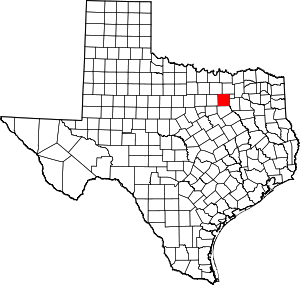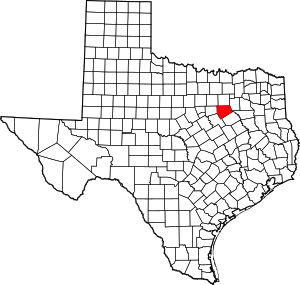Glenn Heights, Texas
Glenn Heights is a city in Dallas and Ellis counties in the U.S. state of Texas. The population was 11,278 at the 2010 census.[5]
Glenn Heights, Texas | |
|---|---|
 Location of Glenn Heights, Texas | |
| Coordinates: 32°32′54″N 96°51′5″W | |
| Country | |
| State | |
| Counties | Dallas, Ellis |
| Government | |
| • Type | Council-Manager |
| • City Council | Mayor Harry Garrett Sonja Brown Machanta Newson Emma Ipaye Ron Adams Shaunte L. Allen Jeremy Woods |
| • City Manager | David A. Hall, J.D. |
| Area | |
| • Total | 7.21 sq mi (18.68 km2) |
| • Land | 7.21 sq mi (18.68 km2) |
| • Water | 0.00 sq mi (0.01 km2) |
| Elevation | 676 ft (206 m) |
| Population (2010) | |
| • Total | 11,278 |
| • Estimate (2019)[2] | 13,377 |
| • Density | 1,855.08/sq mi (716.25/km2) |
| Time zone | UTC-6 (Central (CST)) |
| • Summer (DST) | UTC-5 (CDT) |
| ZIP code | 75154 |
| Area code(s) | 972 |
| FIPS code | 48-29840[3] |
| GNIS feature ID | 1388572[4] |
| Website | www |
Geography
Glenn Heights is located at 32°32′54″N 96°51′5″W (32.548198, -96.851430).[6]
According to the United States Census Bureau, the city has a total area of 7.2 square miles (18.7 km2), all of it land.[7]
History
Development of the community dates back to the late 1960s. N.L. 'Moe' Craddock, a Dallas firefighter, opened a 30-acre (120,000 m2) mobile home park in the area. He helped push for the incorporation of Glenn Heights to prevent his business from being annexed by the city of DeSoto.[8] The town was officially incorporated on September 16, 1969.[9] Mr. Craddock remained active in Glenn Heights politics, serving on the city council during the 1970s and 1980s. He was appointed mayor in 1985 and was elected to that office in 1988, 1990, and 1992.[8]
There were 257 residents living in Glenn Heights at the 1970 census. That figure rose to 1,033 in 1980 and more than doubled for a second consecutive decade to 4,564 by 1990.[10] Lying in the path of suburban sprawl, Glenn Heights' population had surpassed 7,000 by 2000. Despite its rapid rate of growth, more than 50 percent of city land remains undeveloped.[11] It has been said that the City Assistant Manager, City Manager, zoning commission board and the council are all on the take. The only people that get variance's are Big Corporations that are beginning to dominate the city with huge homes and small lots. The zoning commission will approve the big corporation wants, yet will deny a small variance to a young couple who wants to build in the City. The City Manager basically makes the sale for the big corporations, yet will do nothing for the citizens. The City Manager has also screamed and yelled at a citizen like a child having a tantrum; calling him a "liar", "don't point at me". When the citizen gave him a paper, the continued with the tantrum, violently throwing it into the trash can screaming and interrupting another speaker yelling "I don't care". The Demographics are changing because the City council is wanting more money. The percentage of tax may have gone down, but the Huge homes being built on small lots are falsely increasing the value of the properties. Giving the council more hard earned money to waste. The Cities Police and Fire fighters Associations (Scab Unions) unfairly dominate the political landscape getting the council members who will vote them pay raises and new facilities, thinking of themselves and not the people of Glenn Heights. This is a very volatile little community. The City Council and City Manager delete comments and reviews from the city website to prevent so many citizens that put honest statements that are derogatory towards the city manager and council.Glenn Heights has become known as "the little town that just couldn't".
Demographics
| Historical population | |||
|---|---|---|---|
| Census | Pop. | %± | |
| 1970 | 257 | — | |
| 1980 | 1,033 | 301.9% | |
| 1990 | 4,564 | 341.8% | |
| 2000 | 7,224 | 58.3% | |
| 2010 | 11,278 | 56.1% | |
| Est. 2019 | 13,377 | [2] | 18.6% |
| U.S. Decennial Census[12] | |||
As of 2010 Glenn Heights had a population of 11,278. The median age was 29.4. The racial and ethnic composition of the population was 25.2% non-Hispanic white, 49.6% non-Hispanic black, 0.6% Native American, 0.6% Asian, 0.1% non-Hispanic reporting some other race, 2.7% from two or more races and 22.2% Hispanic or Latino.[13]
As of the census[3] of 2000, there were 7,224 people, 2,356 households, and 1,917 families residing in the city. The population density was 1,029.2 people per square mile (397.3/km2). There were 2,565 housing units at an average density of 365.4 per square mile (141.1/km2). The racial makeup of the city was 66.65% White, 25.12% African American, 0.78% Native American, 0.39% Asian, 0.11% Pacific Islander, 5.08% from other races, and 1.87% from two or more races. Hispanic or Latino of any race were 15.74% of the population.
There were 2,356 households, out of which 53.3% had children under the age of 18 living with them, 61.3% were married couples living together, 15.2% had a female householder with no husband present, and 18.6% were non-families. 14.2% of all households were made up of individuals, and 2.2% had someone living alone who was 65 years of age or older. The average household size was 3.07 and the average family size was 3.38.
In the city, the population was spread out, with 35.5% under the age of 18, 8.6% from 18 to 24, 37.2% from 25 to 44, 15.0% from 45 to 64, and 3.7% who were 65 years of age or older. The median age was 28 years. For every 100 females, there were 96.5 males. For every 100 females age 18 and over, there were 93.9 males.
The median income for a household in the city was $51,076, and the median income for a family was $53,548. Males had a median income of $34,411 versus $29,395 for females. The per capita income for the city was $18,693. About 5.5% of families and 7.2% of the population were below the poverty line, including 8.9% of those under age 18 and 8.8% of those age 65 or over.
Education
The Dallas County portion of Glenn Heights is served by the DeSoto Independent School District, while the Ellis County portion is served by the Red Oak Independent School District.
The Dallas County portion is zoned to either Frank D. Moates Elementary School (west of Uhl Rd.) or Woodridge Elementary School (east of Uhl Rd.), Curtistene S. McCowan Middle School, and DeSoto High School.
The Ellis County portion is zoned to Donald T. Shields Elementary School, Red Oak Intermediate School, Red Oak Junior High School, and Red Oak High School.
Transportation
Glenn Heights is the only suburb (except for Cockrell Hill, which is technically an enclave and not a suburb) in the southern half of Dallas County that is a member of Dallas Area Rapid Transit; it has been since DART's inception in 1983. The Glenn Heights Park & Ride Center serves the city. None of DART's current commuter rail lines serve Glenn Heights, nor will any of its proposed extensions.
References
- "2019 U.S. Gazetteer Files". United States Census Bureau. Retrieved August 7, 2020.
- "Population and Housing Unit Estimates". United States Census Bureau. May 24, 2020. Retrieved May 27, 2020.
- "U.S. Census website". United States Census Bureau. Retrieved 2008-01-31.
- "US Board on Geographic Names". United States Geological Survey. 2007-10-25. Retrieved 2008-01-31.
- "Profile of General Population and Housing Characteristics: 2010 Demographic Profile Data (DP-1): Glenn Heights city, Texas". United States Census Bureau. Retrieved January 12, 2012.
- "US Gazetteer files: 2010, 2000, and 1990". United States Census Bureau. 2011-02-12. Retrieved 2011-04-23.
- "Geographic Identifiers: 2010 Demographic Profile Data (G001): Glenn Heights city, Texas". United States Census Bureau. Retrieved January 12, 2012.
- "N.L. 'Moe' Craddock: Firefighter whose business led to formation of Glenn Heights". Joe Simnacker, The Dallas Morning News. 2008-03-19. Retrieved 2009-05-08.
- "Glenn Heights, Texas". The Handbook of Texas online. Retrieved 2009-05-08.
- "2009 Population Estimates by City" (TXT). North Central Texas Council of Governments online. 2009-04-23. Retrieved 2009-05-08.
- "Glenn Heights is a smaller town with big-city amenities". Deborah Fleck, The Dallas Morning News. 2008-04-11. Retrieved 2009-05-08.
- "Census of Population and Housing". Census.gov. Retrieved June 4, 2015.
- 2010 general profile of population and housing characteristics of Glenn Heights from the US Census]


